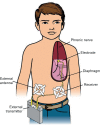Congenital central hypoventilation syndrome: diagnostic and management challenges
- PMID: 29388615
- PMCID: PMC5683295
- DOI: 10.2147/PHMT.S95054
Congenital central hypoventilation syndrome: diagnostic and management challenges
Abstract
Congenital central hypoventilation syndrome (CCHS) is a rare genetic disorder with failure of central control of breathing and of the autonomic nervous system function due to a mutation in the paired-like homeobox 2B (PHOX2B) gene. Affected patients have absent or negligible ventilatory sensitivity to hypercapnia and hypoxemia, and they do not exhibit signs of respiratory distress when challenged with hypercarbia or hypoxia. The diagnosis of CCHS must be confirmed with PHOX2B gene mutation. Generally, the PHOX2B mutation genotype can aid in anticipating the severity of the phenotype. They require ventilatory support for life. Home assisted ventilation options include positive pressure ventilation via tracheostomy, noninvasive positive pressure ventilation, and diaphragm pacing via phrenic nerve stimulation, but each strategy has its associated limitations and challenges. Since all the clinical manifestations of CCHS may not manifest at birth, periodic monitoring and early intervention are necessary to prevent complications and improve outcome. Life-threatening arrhythmias can manifest at different ages and a normal cardiac monitoring study does not exclude future occurrences leading to the dilemma of timing and frequency of cardiac rhythm monitoring and treatment. Given the rare incidence of CCHS, most health care professionals are not experienced with managing CCHS patients, particularly those with diaphragm pacers. With early diagnosis and advances in home mechanical ventilation and monitoring strategies, many CCHS children are surviving into adulthood presenting new challenges in their care.
Keywords: CCHS; PHOX2B; congenital central hypoventilation syndrome; diaphragm pacing; home mechanical ventilation.
Conflict of interest statement
Disclosure The authors report no conflicts of interest in this work.
Figures


References
-
- Weese-Mayer DE, Berry-Kravis EM, Ceccherini I, Keens TG, Loghmanee DA, Trang H, ATS Congenital Central Hypoventilation Syndrome Subcommittee An official ATS clinical policy statement: congenital central hypoventilation syndrome – genetic basis, diagnosis, and management. Am J Respir Crit Care Med. 2010;181(6):626–644. - PubMed
-
- Fleming PJ, Cade D, Bryan MH, Bryan AC. Congenital central hypoventilation and sleep state. Pediatrics. 1980;66(3):425–428. - PubMed
-
- Mellins RB, Balfour HH, Jr, Turino GM, Winters RW. Failure of automatic control of ventilation (Ondine’s curse). Report of an infant born with this syndrome and review of the literature. Medicine (Baltimore) 1970;49:487–504. - PubMed
-
- Trang H, Dehan M, Beaufils F, Zaccaria I, Amiel J, Gaultier C, French CCHS Working Group The French Congenital Central Hypoventilation Syndrome Registry: general data, phenotype, and genotype. Chest. 2005;127(1):72–79. - PubMed
-
- Shimokaze T, Sasaki A, Meguro T, et al. Genotype–phenotype relationship in Japanese patients with congenital central hypoventilation syndrome. J Hum Genet. 2015;60(9):473–477. - PubMed
Publication types
LinkOut - more resources
Full Text Sources
Other Literature Sources
Research Materials

